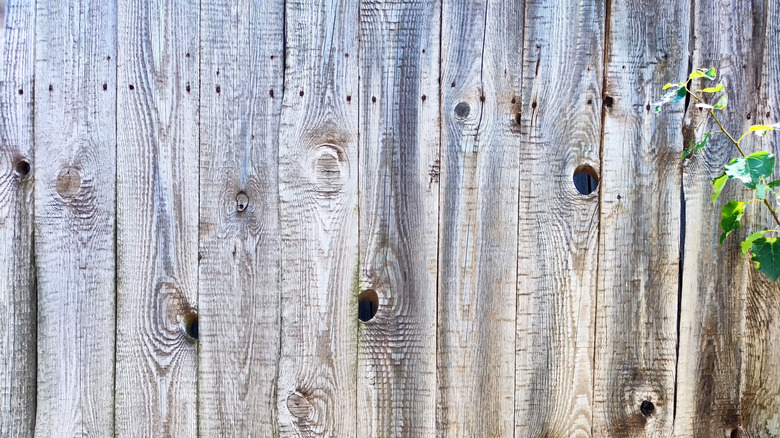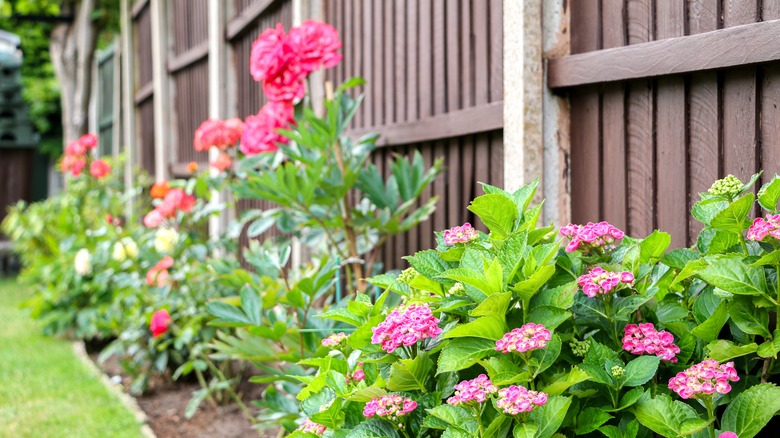Bring Back Some Privacy With Our Tips For Repairing Fence Holes On A Budget
A wood fence starts off as a strong and aesthetically pleasing way to block the view from nosy neighbors. But time, weather elements, and nature can take a toll on the boards, creating holes and gaps that take away from your privacy. Insects, including termites and carpenter ants, often contribute to fence damage. When you're on a budget, replacing the entire fence isn't a feasible option, and finding out how much a wood fence repair will cost you could also be surprising. So creative and inexpensive fixes help you restore your fence when funds are limited.
Wood filler is an inexpensive way to close holes that are 3/8 of an inch wide or smaller. Solvent-based or epoxy wood fillers typically hold up better than water-based wood fillers outdoors, where the weather elements are a factor. Prep the hole by sanding it with coarse sandpaper to create a rough surface that's easier for the wood filler to grip. A putty knife makes it easy to apply the filler into the hole. Once the filler dries for 12 to 24 hours, smooth the surface with medium-grit sandpaper. Staining the area helps it blend in better with the wood fence pickets.
For larger holes or pickets that have several holes, consider replacing the board. Replacing the pieces with the most damage offers an affordable fix compared to replacing everything. Pry the damaged board off the fence, and nail the new board in place, offsetting the location of the nails to create new nail holes for secure attachment.
Grow privacy over the fence holes
Live plants soften the look of the fence while adding color and life to the space. One option for adding flowers and increasing privacy is to attach pots directly to the fence. Choose plants that fill out well or spill over the edges of the pots to cover large sections of the fence. You can also position pots on the ground along the fence to grow tall plants or grow ornamental grasses directly in the ground.
Another option is to grow climbing plants with the support of trellises. Clematis, morning glory, and ivy are options that vine along your fence. Anchor the trellis securely into the ground or attach it to the fence using brackets, screws, nails, or wire. When possible, position the trellis so the structure blocks the holes in the fence. As the vining plants fill out, you'll have even more coverage for the holes and gaps on the fence. If you want to extend the height of your fence for additional privacy, consider adding a lattice section along the top.
You can also create a gorgeous faux greenery wall to add the look of live plants without the upkeep. Choose faux plant panels that are designed for outdoor use. They usually come in smaller panels that you can attach to the fence in any pattern you want. Choose a layout and design based on where the holes are located and how much of the fence you want to cover.
Cover the holes with decorative elements
If you have holes to cover but the fence is still structurally sound, consider adding decorative elements to the fence to block the openings. There are several stunning outdoor wall decor ideas that aren't plants if you want to personalize the look of your fence. Repurposing old items you have around the house or find at thrift stores adds a unique look to your backyard. Consider outdoor mirrors, old windows, or shutters.
Place functional additions strategically to cover holes and increase privacy. Solar-powered fence lights illuminate the space at night, and they come in different sizes and shapes. Lanterns hung from hooks can be positioned to block gaps in the fence while creating a rustic look. Birdhouses and water features are two other functional options for decorating your fence for increased privacy.
You can also get creative with metal, wood, and other materials to cover fence holes. Hang metal medallions, scrolls, or silhouettes of your favorite nature images. Flat wood designs, such as animal cutouts or decorative signs, attach to the fence easily and can cover a large area. For small holes, using similarly sized items, such as marbles or sea glass, and securing them with cement will block the opening and create a mosaic effect. When hanging any decorations on the structure, make sure it's sturdy enough to support the weight of the object.


